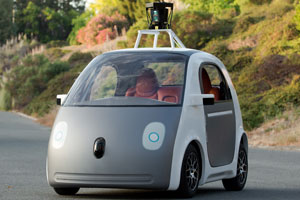
Tech giant Google recently unveiled its futuristic motor. Is it a gimmick, or will computers really be driving us to work soon? Simon Wilson reports.
What’s happened?
Last week, Google unveiled the world’s first prototype of a self-driving car. It’s an odd-looking beast – a cross between an old-style VW Beetle and a souped-up padded golf cart, with a top speed of 25mph. But it’s a major landmark, notable more for what’s missing than what’s present.
There’s no steering wheel, accelerator or brake – merely buttons to stop and start and a screen to show the route. It can be summoned using a smartphone app, and it has sophisticated sensors that can ‘see’ objects more than 200 metres away.
It might not look much, but if Google gets its way, this prototype could mark the biggest revolution in road transport since the invention of the horseless carriage.
Haven’t we seen driverless cars before?
The firm has been working on self-driving cars at its Google X research lab for several years, but until now it had simply been installing specialised radar equipment and sensors into existing Toyotas and Lexuses.
These modified vehicles work by using highly sophisticated lasers to generate a 3D map of the car’s surroundings. The car then combines these with high-resolution maps of the world to produce data models that allow it to navigate its own path.
In tests, the self-driving vehicles have covered some 700,000 ‘autonomous miles’. However, these test cars give the driver the option of grabbing the wheel or slamming on the brakes. Google’s new driverless prototype is radically different, and potentially marks a step change in the development of driverless cars.
Why only ‘potentially’?
Google is not the only player in the self-driving space, and many in the automotive industry believe that self-driving cars will emerge by a process of evolution, not revolution. The key purported benefits of driverless cars are safety, efficiency, reduced congestion, and freeing up the driver’s time to do other things.
Top of the list is safety: humans are unreliable, easily distracted, prone to getting tired or drunk, and have vastly slower reaction times than software. With a computer at the wheel, driving will also be more efficient, leading to environmental and economic benefits.
But many of these benefits are also behind the rapidly growing market in advanced driving aids, such as lane-keeping systems, adaptive cruise control (staying a safe distance from the vehicle in front), and auto-parking systems.
At some point, as these technologies improve further, the car will be doing more than the driver. It won’t be a single leap, but a process.
Who else is involved?
As far back as 2011, BMW sent a robotic car at motorway speeds from Munich to Nuremberg (with a driver on board, just in case).
Audi managed to get a self-driving TTS Coupe to negotiate 156 tight curves along nearly 20km of paved and dirt road on Colorado’s Pikes Peak. Google may be grabbing the headlines, but several conventional firms are working along similar lines.
Nissan plans to put its first fully autonomous vehicle into production by 2020 and BMW, Mercedes-Benz, Cadillac and Toyota are all also working on their own systems.
So what’s next?
According to a report by KPMG and the Center for Automotive Research, the key factor in the development of driverless technology will be the convergence of ‘sensor-based solutions’ (such as those that make advanced driving aids possible) with ‘connectivity-based solutions’ – ie, the wireless technologies that make possible real-time communication from vehicle to vehicle and from vehicle to infrastructure.
Currently, the report argues, there are significant hurdles that must be jumped to make convergence possible. These include improved positioning technology (GPS isn’t accurate enough yet) and high-resolution mapping (today’s digital maps don’t have enough detail).
Do any big hurdles remain?
The other key drivers will be cost and the willingness of drivers to make the leap – two factors that again suggest the process will be gradual rather than disruptive. And if self-driving cars become a reality, would we all just be swapping traffic jams for spam jams? KPMG’s cyber-security team warns that driverless cars may be vulnerable to hacking techniques familiar from other areas of the computing industry.
“Self-drive cars will probably work through internet connectivity, and, just as large volumes of electronic traffic can be routed to overwhelm websites,” says KPMG’s Wil Rockall, “the opportunity for self-drive traffic being routed to created ‘spam jams’ or disruption is a very real prospect.”
The ethics of crashing
A new study of autonomous driving by Noah Goodall, a scientist at the University of Virginia, explores whether robot cars can be taught to make empathetic, moral decisions when an accident is imminent. When a ball bounces out in front of your car, a human driver knows that a child might follow.
And say an oncoming bus is swerving into your lane. One driver might swerve so as to prioritise the safety of his wife and child on the passenger side, says Kyle Stock in Businessweek, while another might respond differently if she spots that the bus is full of children. At the very least, urges Goodall, engineers need to be thinking now about “ethical crashing algorithms“ that might help deal with this problem.